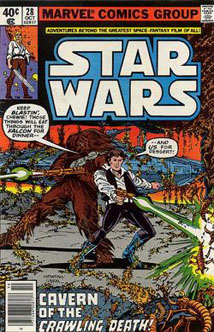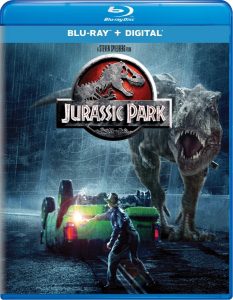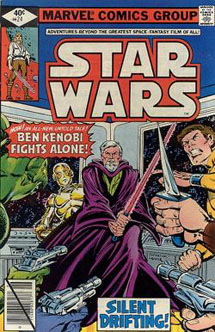Before May 1999, we heard a lot about how the prequel era was off-limits to Expanded Universe writers since George Lucas was saving it for himself. Nonetheless, a few stories from this era slipped through the cracks. The very first one was Marvel issue 24, “Silent Drifting,” which hit newsstands in March 1979.
Written by Mary Jo Duffy, who would later become the regular Marvel writer, it stars Obi-Wan Kenobi during the time of the Old Republic — presumably during the Clone Wars, as artists Carmine Infantino and Bob Wiacek draw him as middle-aged with a beard. While he doesn’t look like Obi-Wan from the prequel era as we know it, I can imagine James Arnold Taylor speaking the dialog from this issue with a slightly sardonic lilt. As he calmly takes command of a pleasure craft being attacked by pirates — and serves as an impromptu arbiter of justice in a shipboard dispute — Obi-Wan is very much in character.
The first Marvel Annual, Chris Claremont’s “The Long Hunt,” which came out in November 1979, also tiptoes into Clone Wars mythology, and again — but accidentally, this time — it works. The gang travels to a planet, Skye, where one clan had pledged loyalty to “three Jedi Knights” — “Obi-Wan Kenobi (and) his pupils.” A rival clan pledged loyalty to Darth Vader. Because Claremont doesn’t name the other two Jedi Knights in the text (of course, he implies that they are Anakin AND Darth Vader, since no one knew they were the same person until May 1980), the story actually works as a cool twist, because one clan fights for Anakin Skywalker, the other for Darth Vader! (Possible ret-con: Maybe the Jedi Knights were Obi-Wan, Anakin and Ahsoka.)

But not all Marvel issues are saved by luck; some are undeniably apocryphal. The first blatant, no-chance-of-a-retcon issue is No. 28, “What Ever Happened to Jabba the Hut?” (To Marvel’s credit, and as evidence that the series shouldn’t be dismissed by continuity lovers, that makes 27-straight issues that fit with continuity, even today. Not a bad stretch.) The misspelling isn’t necessarily Archie Goodwin’s fault, as Hutt only had one “t” in the “Star Wars” novelization (where Wookiee is also misspelled as “Wookie”).
Jabba’s appearance as a walrus-faced biped (a Nimbanel, as serious “Star Wars” geeks know) continues from his portrayal in Howard Chaykin’s movie adaptation (Marvel No. 2). Unlike Obi-Wan being slightly off in Issue 24, there’s really no dodging Jabba’s decidedly thinner look here. He’s also not quite in character, as he goes to the trouble to hunt down Han, rather than lounging in his palace and paying bounty hunters. Most bizarrely, Jabba needs passage on the Millennium Falcon after the showdown concludes, and Han is willing to provide it so long as his debt is erased. Of course, that doesn’t fit with “The Empire Strikes Back.” (To read more about the “Jabba” who isn’t really Jabba, and the best attempt at a retcon, click here.)

We get the second and third parts of “The Hunter” trilogy (which started in No. 16) with No. 27, “Return of the Hunter,” and No. 29, “Dark Encounter.” The Hunter, Valance, is half cool character (he is the very first bounty hunter we meet, other than the hapless Greedo), and half ridiculous character. Valance’s outlook on life, where he despises people who love droids and also hates the fact that many people hate cyborgs (like himself), is nonsensical. It reminds me of the school lunch lady in the “Buffy” Season 3 episode “Earshot.”
Lunch lady: “Vermin, you’re all vermin. You come in and you eat and you eat! Filth!”
Buffy: “I don’t see this being settled with logic.”
When Valance lets Threepio and Luke go at the end of Issue 27, Luke observes that the hunter “sounds like a man who hasn’t made (his mind) up yet.” No. 29 is a visually cool issue in that Valance — protecting Tyler Lucien, a Rebel on the lam who knows the identity of the man who destroyed the Death Star — fights Darth Vader, who seeks that knowledge. Fought over reddish, corrosive waters, it’s reminiscent of the Mustafar battle in “Revenge of the Sith.”
Goodwin does some deft writing in issues 25 and 26, “Siege at Yavin” and “Doom Mission.” He knew the Rebels would have to flee Yavin, yet he didn’t know where their next base would be, so he was hesitant to move them. (After “Empire” came out in May 1980, he was able to tell the Yavin-to-Hoth journey in the daily newspaper strips, later collected in Dark Horse’s “Classic Star Wars.”) But that leaves two questions: Why are the Rebels still on Yavin? And why doesn’t the Empire attack? Goodwin — just barely plausibly — suggests that the Empire doesn’t want to draw the public’s attention to the failure of the Death Star, so it is holding back a bit.
Meanwhile, Baron Tagge (a relative of the Imperial general from “A New Hope”) is a rival of Vader’s within the Empire, so he is willing to take a shot at wiping out the Rebel base. Thus, we get a couple solid adventures in the Yavin system, and a pretty cool idea: Tagge and his TIE fighters hide within an artificially created eye of a storm in the gas giant itself.
This batch of issues wraps with a decent Leia standalone (No. 30, aptly titled “A Princess Alone!”) as she goes undercover among oppressed factory workers on Metalorn. Although she isn’t able to set up an organized resistance on the planet, Leia is confident that she at least plants the seed with her mere appearance and escape (and by dropping news that Alderaan was destroyed by the Empire, which goes against the official story that it was destroyed by a meteor shower). In heavy-handed comic-book fashion, we see a girl literally planting seeds in the ground to complete the metaphor.
Nonetheless, it’s a solid yarn where Goodwin once again shows that he has a good grasp of what the Empire stands for and what the Rebel Alliance is fighting against.

